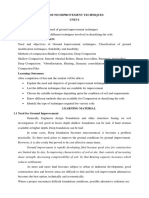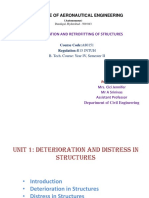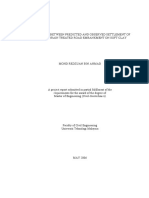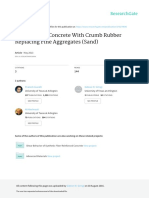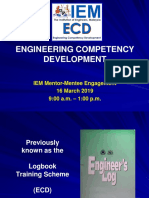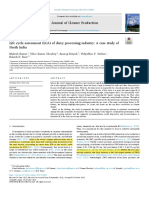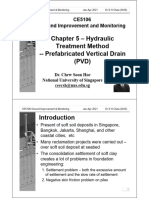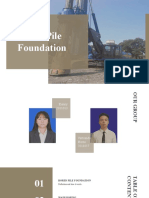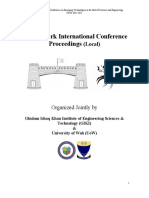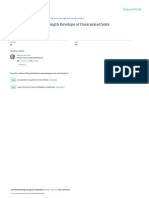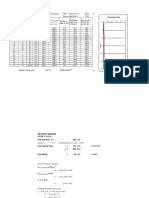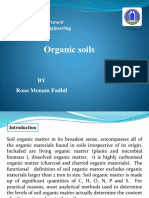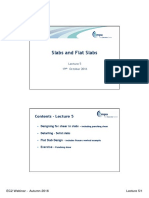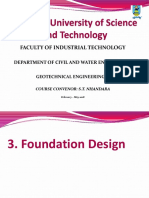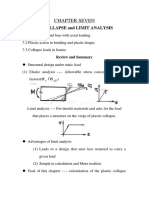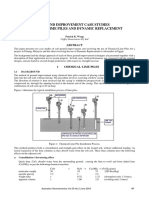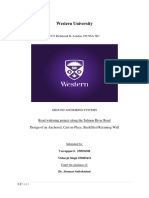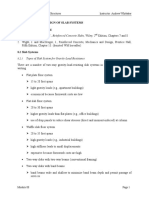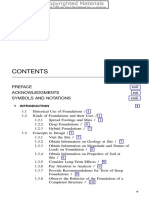Introduction To Earthquakes: Preface Acknowledgments
Introduction To Earthquakes: Preface Acknowledgments
Uploaded by
teamgoodCopyright:
Available Formats
Introduction To Earthquakes: Preface Acknowledgments
Introduction To Earthquakes: Preface Acknowledgments
Uploaded by
teamgoodOriginal Title
Copyright
Available Formats
Share this document
Did you find this document useful?
Is this content inappropriate?
Copyright:
Available Formats
Introduction To Earthquakes: Preface Acknowledgments
Introduction To Earthquakes: Preface Acknowledgments
Uploaded by
teamgoodCopyright:
Available Formats
CONTENTS
Preface xi Acknowledgments
xii
Chapter 1. Introduction
1.1 1.2 1.3 1.4 1.5 Geotechnical Earthquake Engineering / 1.1 Engineering Geology / 1.2 Geotechnical Engineering Terms / 1.2 Symbols and Units / 1.3 Book Outline / 1.3
1.1
Part 1 Introduction to Earthquakes
Chapter 2. Basic Earthquake Principles
2.1 Plate Tectonics / 2.3 2.1.1 Types of Faults / 2.11 2.2 Seismograph / 2.13 2.3 Seismic Waves / 2.14 2.4 Magnitude of an Earthquake / 2.16 2.4.1 Local Magnitude Scale ML / 2.16 2.4.2 Surface Wave Magnitude Scale Ms / 2.18 2.4.3 Moment Magnitude Scale Mw / 2.18 2.4.4 Comparison of Magnitude Scales / 2.19 2.4.5 Summary / 2.20 2.5 Intensity of an Earthquake / 2.21 2.6 Problems / 2.21 2.3
Chapter 3. Common Earthquake Effects
3.1 Introduction / 3.1 3.2 Surface Rupture / 3.1 3.2.1 Description / 3.1 3.2.2 Damage Caused by Surface Rupture / 3.2 3.3 Regional Subsidence / 3.8 3.4 Liquefaction / 3.14 3.4.1 Introduction / 3.14 3.4.2 Settlement and Bearing Capacity Failures / 3.15 v
3.1
vi
CONTENTS
3.4.3 Waterfront Structures / 3.17 3.4.4 Flow Slides / 3.28 3.4.5 Lateral Spreading / 3.31 3.5 Slope Movement / 3.33 3.5.1 Types of Earthquake-Induced Slope Movement / 3.33 3.5.2 Examples of Earthquake-Induced Slope Movement / 3.34 3.5.3 Seismic Evaluation of Slope Stability / 3.44 3.6 Tsunami and Seiche / 3.46
Chapter 4. Earthquake Structural Damage
4.1 4.2 4.3 4.4 Introduction / 4.1 Earthquake-Induced Settlement / 4.2 Torsion / 4.4 Soft Story / 4.6 4.4.1 Definition and Examples / 4.6 4.4.2 Pancaking / 4.10 4.4.3 Shear Walls / 4.15 4.4.4 Wood-Frame Structures / 4.16 4.5 Pounding Damage / 4.18 4.5.1 Impact Damage from Collapse of Adjacent Structures / 4.18 4.5.2 Asymmetry / 4.19 4.6 Resonance of the Structure / 4.20 4.6.1 Soft Ground Effects / 4.21
4.1
Part 2
Geotechnical Earthquake Engineering Analyses
5.3
Chapter 5. Site Investigation for Geotechnical Earthquake Engineering
5.1 Introduction / 5.4 5.1.1 Scope of the Site Investigation / 5.4 5.2 Screening Investigation / 5.6 5.3 Quantitative Evaluation / 5.10 5.4 Subsurface Exploration / 5.11 5.4.1 Borings, Test Pits, and Trenches / 5.11 5.4.2 Soil Sampling / 5.15 5.4.3 Standard Penetration Test / 5.17 5.4.4 Cone Penetration Test / 5.22 5.5 Laboratory Testing / 5.25 5.5.1 Shear Strength / 5.27 5.5.2 Cyclic Triaxial Test / 5.31 5.6 Peak Ground Acceleration / 5.33 5.6.1 Introduction / 5.33 5.6.2 Methods Used to Determine the Peak Ground Acceleration / 5.34 5.6.3 Example of the Determination of Peak Ground Acceleration / 5.36 5.6.4 Local Soil and Geologic Conditions / 5.41 5.7 Report Preparation / 5.41 5.8 Problems / 5.42
Chapter 6. Liquefaction
6.1 Introduction / 6.2 6.2 Laboratory Liquefaction Studies / 6.2 6.2.1 Laboratory Data from Ishihara / 6.2
6.1
CONTENTS
vii
6.2.2 Laboratory Data from Seed and Lee / 6.6 6.3 Main Factors That Govern Liquefaction in the Field / 6.6 6.4 Liquefaction Analysis / 6.10 6.4.1 Introduction / 6.10 6.4.2 Cyclic Stress Ratio Caused by the Earthquake / 6.11 6.4.3 Cyclic Resistance Ratio from the Standard Penetration Test / 6.14 6.4.4 Factor of Safety against Liquefaction / 6.17 6.4.5 Example Problem / 6.18 6.4.6 Cyclic Resistance Ratio from the Cone Penetration Test / 6.19 6.4.7 Cyclic Resistance Ratio from the Shear Wave Velocity / 6.19 6.5 Report Preparation / 6.22 6.6 Problems / 6.22
Chapter 7. Earthquake-Induced Settlement
7.1 Introduction / 7.2 7.2 Settlement versus Factor of Safety against Liquefaction / 7.3 7.2.1 Introduction / 7.3 7.2.2 Methods of Analysis / 7.3 7.2.3 Limitations / 7.7 7.3 Liquefaction-Induced Ground Damage / 7.8 7.3.1 Types of Damage / 7.8 7.3.2 Method of Analysis / 7.9 7.3.3 Example Problem / 7.11 7.4 Volumetric Compression / 7.12 7.4.1 Main Factors Causing Volumetric Compression / 7.12 7.4.2 Simple Settlement Chart / 7.12 7.4.3 Method by Tokimatsu and Seed / 7.13 7.4.4 Example Problem / 7.17 7.4.5 Limitations / 7.19 7.5 Settlement due to Dynamic Loads Caused by Rocking / 7.20 7.6 Problems / 7.21
7.1
Chapter 8. Bearing Capacity Analyses for Earthquakes
8.1 Introduction / 8.2 8.1.1 General, Punching, and Local Shear / 8.2 8.1.2 Bearing Capacity Failures / 8.3 8.1.3 Shear Strength / 8.6 8.1.4 One-Third Increase in Bearing Pressure for Seismic Conditions / 8.7 8.2 Bearing Capacity Analyses for Liquefied Soil / 8.8 8.2.1 Introduction / 8.8 8.2.2 Punching Shear Analysis / 8.10 8.2.3 Terzaghi Bearing Capacity Equation / 8.15 8.2.4 Deep Foundations / 8.19 8.2.5 Other Design Considerations / 8.21 8.2.6 Example Problem / 8.22 8.3 Granular Soil with Earthquake-Induced Pore Water Pressures / 8.27 8.3.1 Introduction / 8.27 8.3.2 Bearing Capacity Equation / 8.27 8.3.3 Example Problem / 8.28 8.4 Bearing Capacity Analysis for Cohesive Soil Weakened by the Earthquake / 8.30 8.4.1 Introduction / 8.30 8.4.2 Bearing Capacity Equation / 8.30 8.4.3 Example Problem / 8.32 8.5 Report Preparation / 8.33 8.6 Problems / 8.36
8.1
viii
CONTENTS
Chapter 9. Slope Stability Analyses for Earthquakes
9.1 Introduction / 9.2 9.1.1 Inertia Slope Stability Analysis / 9.5 9.1.2 Weakening Slope Stability Analysis / 9.8 9.1.3 Cross Section and Soil Properties / 9.9 9.2 Inertia Slope StabilityPseudostatic Method / 9.9 9.2.1 Introduction / 9.9 9.2.2 Selection of the Seismic Coefficient / 9.10 9.2.3 Wedge Method / 9.11 9.2.4 Method of Slices / 9.13 9.2.5 Landslide Analysis / 9.14 9.2.6 Other Slope Stability Considerations / 9.16 9.2.7 Example Problem / 9.18 9.3 Inertia Slope StabilityNewmark Method / 9.25 9.3.1 Introduction / 9.25 9.3.2 Example Problem / 9.29 9.3.3 Limitation of the Newmark Method / 9.29 9.4 Weakening Slope StabilityFlow Slides / 9.32 9.4.1 Introduction / 9.32 9.4.2 Factor of Safety against Liquefaction for Slopes / 9.34 9.4.3 Stability Analysis for Liquefied Soil / 9.36 9.4.4 Liquefied Shear Strength / 9.42 9.5 Weakening Slope StabilityLiquefaction-Induced Lateral Spreading / 9.44 9.5.1 Introduction / 9.44 9.5.2 Empirical Method / 9.46 9.5.3 Example Problem / 9.48 9.5.4 Summary / 9.49 9.6 Weakening Slope StabilityStrain-Softening Soil / 9.50 9.7 Mitigation of Slope Hazards / 9.50 9.7.1 Allowable Lateral Movement / 9.51 9.7.2 Mitigation Options / 9.52 9.8 Report Preparation / 9.55 9.9 Problems / 9.56
9.1
Chapter 10. Retaining Wall Analyses for Earthquakes
10.1 Introduction / 10.2 10.1.1 Retaining Wall Analyses for Static Conditions / 10.2 10.1.2 Retaining Wall Analyses for Earthquake Conditions / 10.9 10.1.3 One-Third Increase in Soil Properties for Seismic Conditions / 10.9 10.2 Pseudostatic Method / 10.10 10.2.1 Introduction / 10.10 10.2.2 Method by Seed and Whitman / 10.12 10.2.3 Method by Mononobe and Okabe / 10.12 10.2.4 Example Problem / 10.12 10.2.5 Mechanically Stabilized Earth Retaining Walls / 10.19 10.3 Retaining Wall Analyses for Liquefied Soil / 10.23 10.3.1 Introduction / 10.23 10.3.2 Design Pressures / 10.24 10.3.3 Sheet Pile Walls / 10.25 10.3.4 Summary / 10.31 10.4 Retaining Wall Analyses for Weakened Soil / 10.31 10.5 Restrained Retaining Walls / 10.32 10.5.1 Introduction / 10.32 10.5.2 Method of Analysis / 10.32 10.5.3 Example Problem / 10.32
10.1
CONTENTS
ix
10.6 Temporary Retaining Walls / 10.33 10.6.1 Static Design / 10.33 10.6.2 Earthquake Analysis / 10.35 10.7 Problems / 10.35
Chapter 11. Other Geotechnical Earthquake Engineering Analyses
11.1 Introduction / 11.1 11.2 Surface Rupture Zone / 11.2 11.2.1 Introduction / 11.2 11.2.2 Design Approach / 11.2 11.2.3 Groundwater / 11.4 11.3 Pavement Design / 11.5 11.3.1 Introduction / 11.5 11.3.2 Flexible Pavements / 11.5 11.3.3 Earthquake Design / 11.6 11.4 Pipeline Design / 11.8 11.4.1 Introduction / 11.8 11.4.2 Static Design / 11.10 11.4.3 Earthquake Design / 11.15 11.5 Response Spectrum / 11.15 11.5.1 Introduction / 11.15 11.5.2 Response Spectrum per the Uniform Building Code / 11.16 11.5.3 Alternate Method / 11.20 11.5.4 Example Problem / 11.21 11.6 Problems / 11.21
11.1
Part 3 Site Improvement Methods to Mitigate Earthquake Effects
Chapter 12. Grading and Other Soil Improvement Methods
12.1 Introduction / 12.3 12.2 Grading / 12.4 12.3 Other Site Improvement Methods / 12.5 12.3.1 Soil Replacement / 12.5 12.3.2 Water Removal / 12.5 12.3.3 Site Strengthening / 12.8 12.3.4 Grouting / 12.8 12.3.5 Thermal / 12.10 12.3.6 Summary / 12.10 12.4 Groundwater Control / 12.10 12.4.1 Introduction / 12.10 12.4.2 Methods of Groundwater Control / 12.12 12.4.3 Groundwater Control for Slopes / 12.12 12.3
Chapter 13. Foundation Alternatives to Mitigate Earthquake Effects
13.1 Introduction / 13.1 13.2 Shallow Foundations / 13.1 13.3 Deep Foundations / 13.2 13.3.1 Introduction / 13.2
13.1
CONTENTS
13.3.2 Pier and Grade Beam Support / 13.5 13.3.3 Prestressed Concrete Piles / 13.17 13.4 Foundations for Single-Family Houses / 13.32 13.4.1 Raised Wood Floor Foundation / 13.34 13.4.2 Slab-on-Grade / 13.36 13.4.3 California Northridge Earthquake / 13.38 13.5 Problems / 13.39
Part 4
Building Codes
14.3
Chapter 14. Earthquake Provisions in Building Codes
14.1 Introduction / 14.3 14.2 Code Development / 14.3 14.3 Limitations of Building Codes / 14.4
Appendix A. Glossaries
Glossary 1 Field Testing Terminology / A.2 Glossary 2 Laboratory Testing Terminology / A.5 Glossary 3 Terminology for Engineering Analysis and Computations / A.11 Glossary 4 Compaction, Grading, and Construction Terminology / A.16 Glossary 5 Earthquake Terminology / A.21 Glossary References / A.27
A.1
Appendix B. EQSEARCH, EQFAULT, and FRISKSP Computer Programs Appendix C. Conversion Factors Appendix D. Example of a Geotechnical Report Dealing with Earthquake Engineering Appendix E. Solution to Problems Appendix F. References
B.1
C.1
D.1
E.1
F.1
Index
I.1
You might also like
- What Is "Ground Improvement?": Soil Improvement and Ground Modification Methods © 2015 Elsevier Inc. All Rights ReservedDocument5 pagesWhat Is "Ground Improvement?": Soil Improvement and Ground Modification Methods © 2015 Elsevier Inc. All Rights ReservedEr Sonu PaswanNo ratings yet
- Geotechnical Problem Solving: Book DescriptionDocument9 pagesGeotechnical Problem Solving: Book DescriptionSadaqat AliNo ratings yet
- Iii Ii Ground Improvement Techniques PDFDocument68 pagesIii Ii Ground Improvement Techniques PDFstructures dptNo ratings yet
- Iare RrsDocument180 pagesIare RrsDhuha ANo ratings yet
- Lecture-Introduction To EC2Document48 pagesLecture-Introduction To EC2denyfate100% (1)
- Application of Buckingham Theorem in Predicting Sanding Rate From Unconsolidated Formation Bounded by An Aquifer in The Niger Delta-2Document38 pagesApplication of Buckingham Theorem in Predicting Sanding Rate From Unconsolidated Formation Bounded by An Aquifer in The Niger Delta-2daniel ndemNo ratings yet
- Mohd Redzuan Ahmad MFKA2006Document23 pagesMohd Redzuan Ahmad MFKA2006hidayat zahariNo ratings yet
- C: Finding Code That Counts With Causal Profiling: Charlie Curtsinger Emery D. BergerDocument14 pagesC: Finding Code That Counts With Causal Profiling: Charlie Curtsinger Emery D. BergerkhaledmosharrafmukutNo ratings yet
- Advances in Civil Engineering Materials 2013 Siringi-1Document16 pagesAdvances in Civil Engineering Materials 2013 Siringi-1KanchanNo ratings yet
- Similitude Theory and Applications: January 2010Document11 pagesSimilitude Theory and Applications: January 2010Ion SococolNo ratings yet
- Outline: Dr. Shakil AhmadDocument14 pagesOutline: Dr. Shakil AhmadWaQar SaleemNo ratings yet
- Stabilization of Peat Soil Using Locally AdmixtureDocument7 pagesStabilization of Peat Soil Using Locally AdmixtureElaMazlanNo ratings yet
- D - Internet - Myiemorgmy - Intranet - Assets - Doc - Alldoc - Document - 16245 - Engineering Competency Development PDFDocument88 pagesD - Internet - Myiemorgmy - Intranet - Assets - Doc - Alldoc - Document - 16245 - Engineering Competency Development PDFEugene Jin LeowNo ratings yet
- Lecture 1a Analysis and Design of Wind Loading PDFDocument61 pagesLecture 1a Analysis and Design of Wind Loading PDFazhar ahmadNo ratings yet
- Definitions and Engineering Classifications of Tropical Lowland PeatsDocument9 pagesDefinitions and Engineering Classifications of Tropical Lowland PeatsRoberto RizzoNo ratings yet
- LCA-Case ExampleDocument13 pagesLCA-Case ExampleIrfanNo ratings yet
- SWOT AnalysisDocument10 pagesSWOT AnalysiskrystelNo ratings yet
- UMS Postgraduate Studies RuleDocument38 pagesUMS Postgraduate Studies Ruleaibramai3No ratings yet
- CE5106-2021 - Ch5 - PVDDocument55 pagesCE5106-2021 - Ch5 - PVDrihongkeeNo ratings yet
- Types of SoilDocument2 pagesTypes of SoilMarilyn Torremocha OmpadNo ratings yet
- Kelompok 1 Bored PileDocument22 pagesKelompok 1 Bored PileVernondo HorseNo ratings yet
- Example 2D Spacing of Wick Drain FE PlaxisDocument10 pagesExample 2D Spacing of Wick Drain FE Plaxisy zhaoNo ratings yet
- GeoSS 2nd President Seminar PDFDocument2 pagesGeoSS 2nd President Seminar PDFKheng BoonNo ratings yet
- Soil Stabilization Using Ground Granulated Blast Furnace Slag (GGBS)Document7 pagesSoil Stabilization Using Ground Granulated Blast Furnace Slag (GGBS)Civil EngineeringNo ratings yet
- AllplanPrecast Product enDocument20 pagesAllplanPrecast Product enCristian MorarNo ratings yet
- Soil Stabilization Using Crumb RubberDocument36 pagesSoil Stabilization Using Crumb RubberPRETTY MARYNo ratings yet
- Shear Strength EnvelopeDocument7 pagesShear Strength EnvelopeMalek AboZregNo ratings yet
- PRESSIBILITY OF SOIL - Part1 PDFDocument60 pagesPRESSIBILITY OF SOIL - Part1 PDFChrysler Valdez LazaroNo ratings yet
- Settlement Settlement of Shallow Footings On Layered Soil State of The Art of Shallow Footings On Layered Soil State of The ArtDocument8 pagesSettlement Settlement of Shallow Footings On Layered Soil State of The Art of Shallow Footings On Layered Soil State of The ArtAnshuman SinghNo ratings yet
- Humeslab® System Technical Manual: Issue 1Document60 pagesHumeslab® System Technical Manual: Issue 1Chee Soon LeeNo ratings yet
- Design of Road DrainageDocument53 pagesDesign of Road DrainageSky Fire100% (1)
- Consolidation CorelationsDocument11 pagesConsolidation CorelationsChandra MouliNo ratings yet
- STatnamic - UTM Thesis 2005Document19 pagesSTatnamic - UTM Thesis 2005kuntumNo ratings yet
- SKAB4022 Short Proposal - Nur Amalina Binti IshakDocument16 pagesSKAB4022 Short Proposal - Nur Amalina Binti Ishakazhar ahmadNo ratings yet
- Micropile - Design and ALLpile AnalysisDocument16 pagesMicropile - Design and ALLpile Analysiskartik vNo ratings yet
- Shape Accel ArrayDocument22 pagesShape Accel Arraydirafly3566No ratings yet
- Organic Soils: BY Roaa Monam FadhilDocument18 pagesOrganic Soils: BY Roaa Monam Fadhilroaa100% (1)
- Coefficient of ConsolidationDocument15 pagesCoefficient of ConsolidationSai KumarNo ratings yet
- Lecture 5 Slabs and Flat Slabs PHG N Rev13 15 Oct 16Document40 pagesLecture 5 Slabs and Flat Slabs PHG N Rev13 15 Oct 16josNo ratings yet
- Progressive Collapse BasicsDocument11 pagesProgressive Collapse BasicstoxicdogNo ratings yet
- Shallow FoundationsDocument101 pagesShallow FoundationsTanaka ChiripashiNo ratings yet
- Calculation of Load Due To Water Tank On The FoundationDocument3 pagesCalculation of Load Due To Water Tank On The FoundationDEBASIS BARMANNo ratings yet
- The Effects of Patch Loads On Thin-Walled Steel Silos: M. Gillie, J.M. RotterDocument18 pagesThe Effects of Patch Loads On Thin-Walled Steel Silos: M. Gillie, J.M. RotterAnonymous wWOWz9UnWNo ratings yet
- Plastic Collapse PDFDocument13 pagesPlastic Collapse PDFrajashrismdNo ratings yet
- CE 632 Shallow Foundations Part-1Document39 pagesCE 632 Shallow Foundations Part-1mkbijuNo ratings yet
- Ground Improvement Case Studies Chemical Lime PilesDocument14 pagesGround Improvement Case Studies Chemical Lime PilesHanumantha Rao BNo ratings yet
- 2 Pile Group Eccentricity Limit Charts: March 2019Document8 pages2 Pile Group Eccentricity Limit Charts: March 2019shahid aliNo ratings yet
- GLT Engineers Private, Singapore: Foundation DesignDocument2 pagesGLT Engineers Private, Singapore: Foundation DesignRio HandokoNo ratings yet
- Soft Ground ImprovementDocument15 pagesSoft Ground ImprovementChua Chim Huee100% (3)
- Enhancement of Mechanical Properties of Concrete by Using NanoparticlesDocument5 pagesEnhancement of Mechanical Properties of Concrete by Using NanoparticlesInternational Journal of Innovative Science and Research TechnologyNo ratings yet
- Plastic Analysis of A StructureDocument19 pagesPlastic Analysis of A Structurejana42100% (1)
- Project Report - Ground Anchoring SystemsDocument37 pagesProject Report - Ground Anchoring SystemsShreedhar100% (1)
- Ground Improvement AssignmentDocument31 pagesGround Improvement AssignmentYingYigaNo ratings yet
- Quakecore Opensees Training Workshop 2017: Geotechnical Analysis in OpenseesDocument70 pagesQuakecore Opensees Training Workshop 2017: Geotechnical Analysis in OpenseesTariq MahmoodNo ratings yet
- TERAO Presentation August 2022Document48 pagesTERAO Presentation August 2022LuatNguyenNo ratings yet
- Borepile Work Procedure - MJPN-PGAS-3514-CV-PR-008Document10 pagesBorepile Work Procedure - MJPN-PGAS-3514-CV-PR-008Danu SutantoNo ratings yet
- Module 08Document50 pagesModule 08waleed hassanNo ratings yet
- A Catalogue of Details on Pre-Contract Schedules: Surgical Eye Centre of Excellence - KathFrom EverandA Catalogue of Details on Pre-Contract Schedules: Surgical Eye Centre of Excellence - KathNo ratings yet
- Preface Xvii Acknowledgments Xxi Symbols and Notations XxiiiDocument11 pagesPreface Xvii Acknowledgments Xxi Symbols and Notations XxiiiAndré OliveiraNo ratings yet


